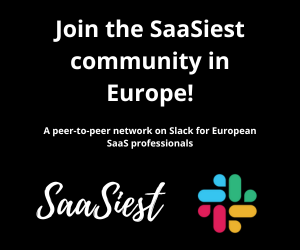
What if the secret to your product’s success lies in the voices of your customers? In the world of SaaS, we often talk about being customer-centric, gathering feedback, and improving experiences. But how many companies truly embrace their customers as co-creators in their product journey? It’s one thing to listen; it’s another to let those voices shape your strategy, spark innovation, and drive meaningful change.
At SaaSiest London, Danielle Delahunty James, Head of Product Marketing at Paddle, took the stage to dive deep into this transformative approach. If you’ve ever wondered how to turn customer insights into actionable strategies that deliver real impact, Danielle’s insights are exactly what you need. Let’s uncover her roadmap for embedding the customer voice into your product strategy and making it the cornerstone of your success.
The importance of the customer voice
The customer voice is more than a source of feedback, it’s a fundamental driver of successful product strategies. While the principles of leveraging customer insights are widely acknowledged, the real challenge lies in consistently applying and integrating these practices within an organization.
“I’m not going to teach you any tips or tricks or shortcuts to amplifying the customer’s voice. These are all the fundamentals that many of you already know, but it’s all about building that muscle, remembering how to do these things, and being really consistent with it,” shared Danielle Delahunty James, emphasizing the importance of consistency and discipline in amplifying the voice of the customer.
Who is paddle?
To provide context, Danielle introduced Paddle’s mission and offerings. Paddle focuses on helping customers operate and grow by providing a comprehensive billing platform that includes payments, tax, and subscription management. Additionally, Paddle acts as a merchant of record, handling tax compliance and operational complexities behind the scenes. Their supplementary products drive insights, analytics, and growth tools, catering specifically to the SaaS niche.
The pitfall of ignoring the customer voice
The consequences of neglecting customer feedback can be detrimental to product success. Danielle Delahunty James used a powerful visual from the Product Marketing Alliance to illustrate this point. She explained that without actively listening to customers, businesses risk developing products that, while potentially appealing on the surface, may ultimately fall short in providing genuine value. This misalignment between product offerings and actual customer needs often results in wasted resources and missed opportunities.
“If you’re not listening to your customers, you are definitely missing the mark,” Danielle emphasized, underscoring how critical it is to maintain an ongoing dialogue with users to ensure that products evolve in line with their true needs and expectations. By disregarding this valuable input, companies can easily veer off course, leading to disappointing customer experiences and hindering long-term growth.
Five strategies to amplify the customer voice
1. Building a continuous feedback loop
The first strategy revolves around establishing a continuous feedback loop to understand customers’ evolving needs. Danielle shared an example of a SaaS marketing agency using a project management tool. Initially, the tool addressed their specific pain points, but as the agency grew, the tool’s features no longer matched their expanding needs.
To prevent this mismatch, continuous feedback is essential. This involves:
- Short-form surveys: Immediate, day-to-day data collection through in-app surveys or change logs.
- Long-term surveys: Annual or biannual surveys that provide granular insights and allow for year-over-year comparisons.
2. User testing
In 2022, Paddle conducted a comprehensive annual customer survey, and one key theme that emerged was the demand for more flexible subscription models and APIs. This feedback became a guiding force as the team began rebuilding their platform in 2023. The challenge, however, was how to incorporate these customer requests in a way that still ensured scalability and repeatability, while also positioning the product to attract new business.
User testing played a crucial role in achieving this balance. By running early access programs and conducting A/B testing before launching new features or updates, companies like Paddle can validate their assumptions and refine their offerings based on real-world customer feedback. This approach helps bridge the gap between customer expectations and the actual product experience.
3. Creating customer advisory boards and user groups
Customer advisory boards and user groups serve as strategic and community-driven platforms for gathering insights.
- Customer advisory boards: These are long-term, strategic groups comprising top-tier customers who help steer the overall product roadmap. They provide mutual success by co-developing features that align with both the company’s and customers’ needs.
- User broups: These community-driven groups focus on best practices and peer-to-peer advice. They offer valuable day-to-day insights and foster a sense of community among users.
It’s important to select strategic customers for advisory boards and create user-specific groups to address different segments’ unique needs.
4. Rolling out early access programs
Early access programs allow customers to engage deeply with product development by testing features before general release. This strategy not only enhances product quality by identifying bugs early but also involves customers in shaping the product roadmap.
“Customers are more patient and open to issues when they know they’re part of the development process,” Danielle noted. This involvement leads to products that better meet customer needs and drive higher engagement.
5. Cross-functional alignment
The final strategy is ensuring cross-functional alignment within the organization. This involves integrating customer insights into the product roadmap by fostering collaboration across different teams, such as marketing, sales, and customer success.
Key steps include:
- Regular joint meetings: Consistent touchpoints for teams to share insights and align on goals.
- Shared KPIs and metrics: Defining common objectives like NPS scores, churn rates, and product adoption metrics.
- Product steering groups: Cross-functional cohorts that review and prioritize features based on comprehensive customer insights and market requirements.
At Paddle, the CEO views the customer voice as a pipeline KPI, ensuring that every closed deal is backed by meaningful customer interactions and feedback.
The continuous journey of adaptability
Danielle concluded his session by reiterating that amplifying the customer voice is not a one-time effort but an ongoing commitment. By consistently integrating customer insights into people, culture, and strategy, businesses can navigate the complexities of growth and build products that truly resonate with their users.
“Flexing that muscle and finding a cohesive way to bring it all together is crucial because every team within this cycle has different insights that can drive the best possible outcomes for your product strategy.” – Danielle Delahunty James
For businesses aiming to scale sustainably, embracing these five strategies will ensure that the customer voice remains a central pillar of their product strategy, driving long-term success and growth.




